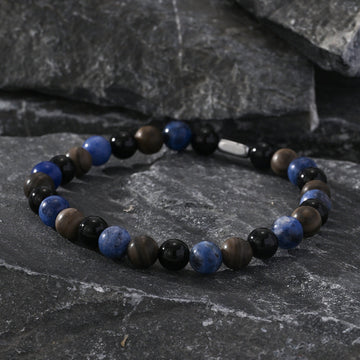When men choose stone bracelets, they need to comprehensively consider six dimensions: material, design, size, craftsmanship, functionality and personal style fit. The following are specific points to note:
First, material: A balance between naturalness and durability
Natural materials are preferred: Choose natural stones such as jade (such as Hetian jade, jadeite), crystal, obsidian, etc., and avoid synthetic or dyed materials. The warm and mellow texture of natural stone is more in line with the composed and steady temperament of men.
Durability considerations: Wooden bracelets (such as those made of small-leaf rosewood) should be protected from water and moisture to prevent cracking. Crystal bracelets should be kept away from hard objects to prevent them from cracking.
Special material tip: Obsidian bracelets often have rainbow eyes. Pay attention to whether the polishing process is fine. Inferior polishing is prone to scratches.
Second, Design: The trade-off between simplicity and individuality
Avoid excessive decoration: The design of men's bracelets should be simple and elegant. It is advisable to avoid inlaying too many small diamonds or intricate patterns. Single-stone inlaying or solid-color designs can enhance the texture.
Style adaptation
For business occasions: Choose a narrow design (8-12mm in width), such as obsidian or ebony bracelets, for a low-key and steady look.
For casual occasions: You can try wide designs (with a width of over 15mm) or rough textures, such as meteorite patterns or tiger's eye bracelets.
Cultural symbols: If you prefer a Chinese style, you can choose traditional patterns such as meander patterns and cloud patterns. If you pursue a modern look, you can try geometric cutting or matte treatment.
Third, size: The golden ratio that fits the wrist
Measurement method: Wrap a soft tape measure around the thickest part of the wrist once, and add 1-2cm to the inner diameter of the bracelet. For example, if the wrist circumference is 18cm, it is recommended to choose a bracelet with an inner diameter of 19 to 20cm.
Open type is more flexible: Open or hinged bracelets can be adjusted in size and are suitable for people with large changes in wrist size (such as thicker wrists after exercising).
Key to trying it on: After wearing it, it should be able to slide smoothly through the wrist joint and not slide to the back of the hand due to movement.
Fourth, craftsmanship: Details determine quality
Setting technique: If you choose the metal stone setting style, you need to check whether the setting is firm to prevent the gemstone from falling off. You can gently tap the edge of the bracelet and listen to whether the sound is clear (a hollow sound may indicate there is a gap inside).
Polishing treatment: The surface of high-quality bracelets should be smooth and free of flaws. For dark stones such as obsidian, it is necessary to check whether the rainbow eyes are symmetrical.
Edge polishing: The edges of the bracelet should be smooth to avoid scratching the wrist.
Fifth, functionality: Energy and symbolic meaning
Energy stone selection: If you pursue energy implications, you can choose obsidian (for warding off evil), tiger's eye (for boosting confidence), agate (for balancing energy), etc.
Cultural symbol: Hetian jade symbolizes the virtue of a gentleman and is suitable for men who pursue cultural connotations. Ebony wood symbolizes tenacity and is suitable for business people.
Matching suggestions: If you wear a watch, it is recommended to choose a bracelet that matches the style of the watch (such as a metal strap with a metal bracelet inlaid with stones).
Sixth, personal style matching: Show taste through details
Age fit
For those aged 20 to 30: You can choose styles with strong design sense, such as geometrically cut crystal or matte titanium steel bracelets.
For those aged 30 to 40: It is recommended to choose narrow-striped classic pieces, such as obsidian or Hetian jade, to highlight maturity and stability.
Body type adaptation
Slender and tall body type: Suitable for wide bracelets to balance the visual proportion.
Robust build: Avoid overly thin rods and opt for a rugged style for a more harmonious look.
Occasion adaptation
For formal occasions: A monochrome narrow bracelet (such as pure obsidian) appears more understated.
For casual occasions: You can try multi-stone combinations or distressed bracelets.
Seventh, a guide to avoiding pitfalls
Beware of dyed stone: Use a cotton swab dipped in alcohol to wipe the surface of the bracelet. If the color fades, it may be dyed.
Avoid cheap metals: If you choose a metal inlaid stone style, it is recommended to select 925 silver or titanium steel materials, and avoid materials such as copper and gold plating that are prone to fading.
Refuse excessive profit and premium: The price range of jade bracelets is wide. It is necessary to understand the market situation and avoid being misled by gimmicks such as "master's enlightenment".
Through the above six points of screening, men can find stone bracelets that not only match their personal style but also have high quality, avoiding the feeling of being "rustic" or "cheap" due to blind selection.







